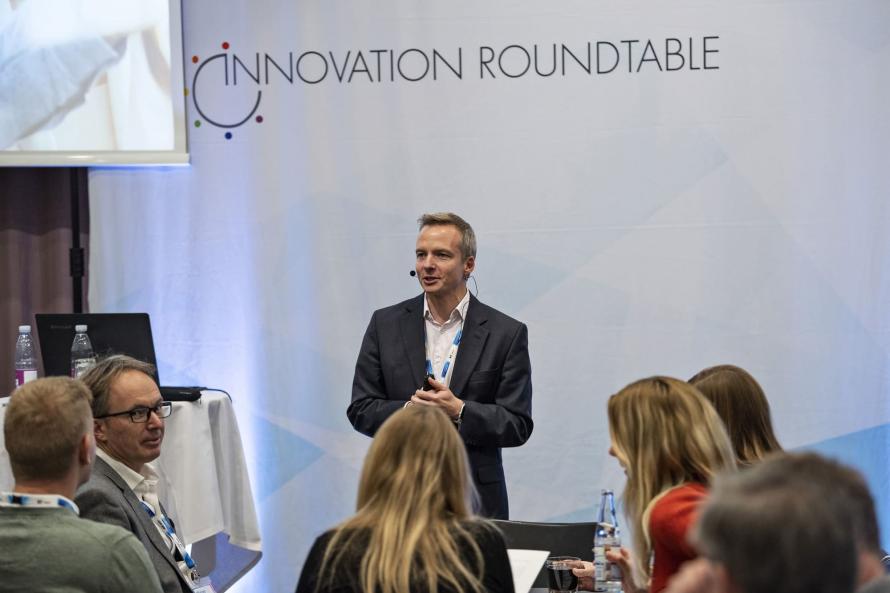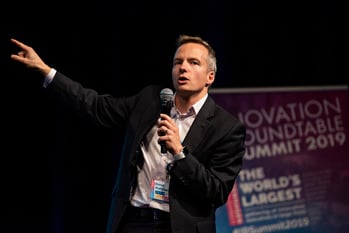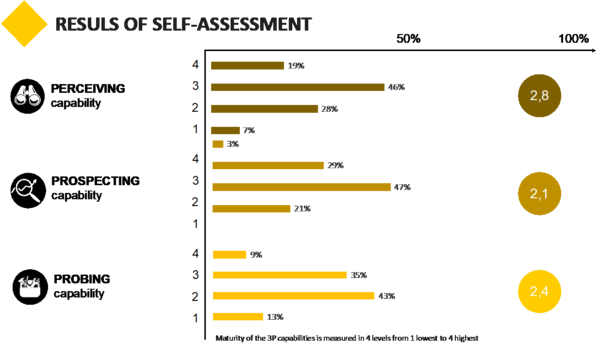What did an EDHEC professor learn from his participation in the Innovation Roundtable Summit?
René Rohrbeck, Professor of strategy and Director of the EDHEC Chair for Foresight, Innovation and Transformation, participated in the Innovation Roundtable Summit held last week at Copenhagen with…

René Rohrbeck, Professor of strategy and Director of the EDHEC Chair for Foresight, Innovation and Transformation, participated in the Innovation Roundtable Summit held last week at Copenhagen with 68 large corporates. Professor Rohrbeck was conducting a workshop: the Foresight Lab. Here what he learnt:
In short, companies have built up good sensors for change and increasingly engage in venturing and probing into the future, but most lack the ability to engage in systems thinking and prospecting into the future and thus fail to form unique strategies.
The end of sustainable competitive advantages?
R.R - For many firms it came as a wake-up call, when Rita Gunther McGrath Rose - a well-renowned american strategic management scholar and professor of management at the Columbia Business School - the alarm that firms can no longer expect to sail smoothly while being propelled by a sustainable competitive advantage. Instead, increased environmental uncertainty and volatility in their industries imply that firms in the future will have to settle for building temporal competitive advantages. The markets in which they operate may in the future only exist for few years after which they disappear or change their nature so radically, that old key success criteria become ineffective. She concludes that firms will need to build a set of different capabilities that allow them to build and profit from a transient advantage with which they compete for pockets of value that may be depleted after only few years.
An Example?
R.R - Consider for example the development of the iPhone. Before its introduction the telecommunication operators (Telcos), occupied the dominant position in the industry, leveraging on their control over the customer interface and their established customer base. They would traditionally be able to earn thick margins on communication revenues and even be able to demand a share of the profit from the phone manufactures. Even the mighty Nokia would fear being locked out of a national market by a dominant Telco, who refuses to put Nokia devices into its catalogue. By introducing a completely new device category, which became known as a smart phone, Apple radically changed the power distribution in the industry. Apple moved from market to market signing deals with Telcos which measured by revenue were much larger than Apple at that time. The new competitive advantage of Apple allowed to force Telcos to hand over part of their revenue in return for the exclusive right to sell Apple’s iPhone. But this power crumbled quickly and already after the first product generation, many of the revenue sharing clauses were taken out of the contracts as rival smart phone manufacturers entered the scene and watered-down Apple’s competitive advantage.
This pattern of strong competitive advantages that are only short lived is becoming more frequent as markets grow ever more transparent and traditional entry barriers, such as scale advantages, exclusive distribution networks and powerful R&D units are losing their value. In consequence, the capabilities that served in a sustainable advantage world, are losing their relevance and today the question is, which new capabilities are necessary to survive and succeed in a transient advantage economy.
What capabilities firms need to build to succeed?
R.R - From our research on Corporate Foresight and its impact on firm performance we have learned that there are three key capabilities that firms need to build, which we call the 3Ps of future FITness (FIT being the acronym for Foresight, Innovation and Transformation):

- Perceiving which entails scanning for signals that allow organizations to prepare for threats and capitalize on opportunities earlier, providing a foresight advantage.
- Prospecting which entails anticipating the consequences for the organizations and possibly also the implications for the entire industry, providing and innovation advantage.
- Probing which entails real-world testing of solutions in order to mobilise resources and improve response time, providing a transformation advantage.
We investigated the state of preparedness for a transient advantage economy of 68 companies that participated in our Foresight Lab at the Innovation Roundtable Summit in Copenhagen. Using our future FITness maturity model, we invited the companies to self-assess their capabilities along the 3Ps.
The results in the figure below show that almost more than three out of five companies have responded to increased volatility and uncertainty by developing strong sensors and achieved a level three or four maturity, which allows them to spot 80% of all trends that will shape their industry and some of them ahead of their competitors. In comparison, with earlier surveys this is a significant increase on the perceiving capability.
Also remarkable is that many firms were reporting to have invested in venturing programs and corporate accelerators, which is reflected by more than two out of five companies having level three or level four probing capabilities, which would involve dedicated units and budgets for experimenting and venturing into new markets and product categories.

The least developed capability is the prospecting capability which involves using scenarios and other systems thinking tools to develop multiple plausible pictures of the future and alternative strategies. It would also imply that companies are conscious about systemic effects that create non-linear change patterns and exponential growth. Level four firms would also actively monitor tipping points to determine the right moment to enter and later exit a market. Here however only 3% of participants would claim to possess such capabilities.
This weakness in prospecting can also be expected to reduce a firm’s ability to develop unique and winning strategies, which have also become known as ‘great strategies’. Examples of firms with great strategies include Starbucks, Apple, Airbnb, Dropbox, Walmart and others. These companies all have developed strategies that were new, unique and transformational for the industry. Such great strategies seem to leverage on early and sometimes privileged insights into weak signals that announce change. Companies introducing great strategies often use small bets that allow them to learn fast and adapt their strategy. Both the privileged insights into future change drivers and gained from probing need to be combined to enable the leadership team to make cognitive leaps that ultimately enable them to develop and execute on great strategies.
As a conclusion..
R.R - It seems to be vital that organizations complement their buildup of perceiving and probing capabilities with training their upper and middle management in systems thinking and scenario-based planning and strategizing. This enables them to plan with non-linear change patterns and identify tipping points which they can leverage for building transient advantages. In a second step the development of a prospecting routine and its integration with the strategy process is key to boost strategic agility. In a transient advantage economy building perceiving, prospecting and probing capabilities is no longer optional and will be key to ensure business continuity and success in the 21st century.



